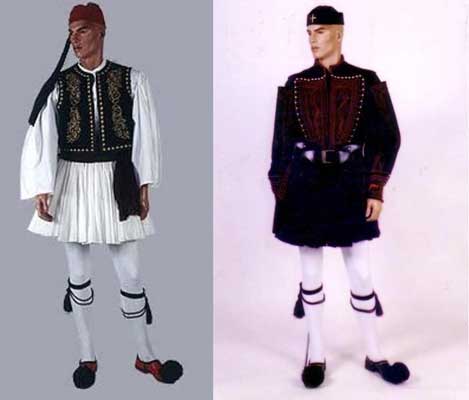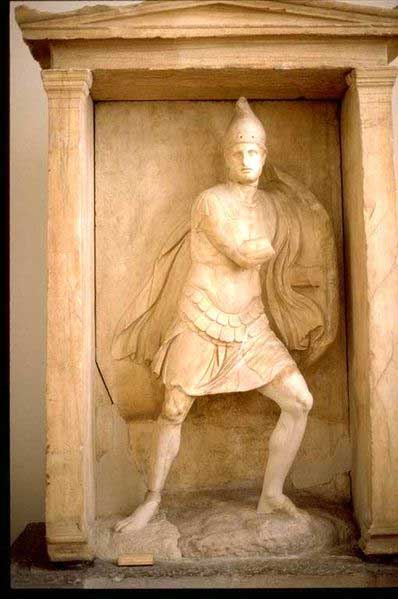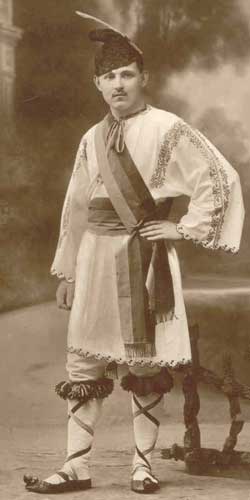|
|
 . .
Greek Foustanelles - (right) - the Makedonomahi, which is from Macedonia, the northern most region of Greece. This costume is also known as the Pavlos Melas. Pavlos Melas was a general from Athens who fought for the freedom of Macedonia, against the Ottoman Empire. This costume is similar to the Tsolia, which is worn by the modern day soldiers, the Evzones(Εύζωνες). (left) - The Foustanella (Tsolias). It was established by Otto, the first King of Greece, as the formal court dress in the middle of the 19th century, prevailed in the urban centers of Moreas (Peloponnese) and Roumeli (Central Greece). This dress was originally the military outfit of the Greek chieftains. The waistcoat is called the “fermeli” and has panels hanging from the back. The men wear a white shirt with puffy sleeves under the fermeli that closes in front. The “foustanella” is the pleated skirt that is made of approximately 350 pleates called “langolia.” The Foustanela has changed in the meaning of detailed work, the length of the “fousta”, and, sometimes, the number of jackets worn. The sleeves have become decorative, resembling wings without the function of sleeves. After all the changes, it has become the standard Pan-Hellenic male costume worn today. Fustanella (for spelling in various languages, see chart below) is a kilt-like garment worn by men in the Balkans until the 19th century and is frequently identified with the elite Greek ceremonial unit of Presidential Guard, the Evzones. Etymology The ultimate derivation is from the Italian fustagno, referring to the fustian fabric of the early kilts. This in turn derives from Medieval Latin fūstāneum, perhaps a diminutive form of fustis, "wooden baton"; though the word may also derive from Fostat, a suburb of Cairo where cloth was manufactured.
Early history The modern fustanella probably originated in the Ottoman vilayet of Yanya, which comprised much of the region of Epirus, today divided between Albania and Greece and inhabited primarily by ethnic Greeks. The use of the garment was probably spread by klephtic bands via Epirus into the rest of Greece during the 18th and 19th centuries. Similar garments exist as part of the folk costume as far north as Romania and as far east as Syria, with nationalists on every side claiming the garment to be an indigenous creation. Similarities to historical garments in literature and on art objects make these claims difficult to prove or disprove. One claim of an ancient link to the modern Fustanella involves an ancient statue dated from the 3rd century BC in Kerameikon (a part of Athens to the northwest of the Acropolis) shown here above. Another claim involves a small figure from the 5th century BC in Slovenia, evidenced here. Another one was found in the outskirts of the Ancient Greek city of Epidamnus (modern Durrës, Albania, ca. 30 km W of Tirana) [1]. Another claim involves a very ancient statue dated to c. 500 BC and wearing a fustanella-like garment. The statue carved in a niche in the Cave of Archedemos the Nympholept [2][3], near Mount Hymettus in Athens. Archedemos, although living in Athens, came from the Spartan colony of Thera. This is why he carved himself wearing the dorian tunic. The Dorian tunic was also a garment of Kouretes. Possible Vlach origin Another theory is that this type of garment was brought from the territoy comprising modern Romania, by the Aromanians (see Romania in the Dark Ages). The ethymology could also be explained in this way: in Romanian, fuşte means "lance"/"wooden baton", from latin fustis. A diminutive of it is fus, meaning spindle. Hence, fusta means a fabric made using a fus. The -ela termination is a typical Romanian ending of diminutives, in this case of the Romanian fusta, meaning skirt. Also, the territory were the fustanella was first used in the southern Balkans, that is Epirus.
Romanian Calusari dancer from Arad, dressed in a traditional Romanian costume, early 20th century. Notice the fustanella type garment, simmilar with the costumes of the Morris dancers and the costumes of the Aromanians. Evolution The garment is made from long strips of linen sewn together to make a pleated skirt. Some Greeks, such as general Theodoros Kolokotronis had almost four hundred pleats in their garments, one for each year of Turkish rule over Greece. The style evolved over time. In the 18th and early 19th centuries, the skirts hung below the knees, and the hem of the garment was gathered together with garters and tucked into the boots to create a "bloused" effect. Later, during the Bavarian regency, the skirts were shortened to create a sort of billowy pantaloon that stopped above the knee; this garment was worn with hose, and either buskins or decorative clogs. This is the costume worn by the modern Greek evzones Presidential Guard. While the image of warriors with frilly skirts tucked into their boots may seem impractical to a contemporary audience, it should be noted that modern paratroopers use a similar method to blouse their trousers over their jumpboots. Lace was commonly worn on military uniforms in the west until well into the 19th century, and gold braid and other adornments still serve as markers of high rank in formal military uniforms. Fustanella were very labor-intensive and thus costly, which made them a status garment that advertised the wealth and importance of the wearer. Western observers of the Greek War of Independence noted the great pride which the klephts took in their foustanella, and how they competed to outdo each other in the sumptuousness of their costume.
The author Oscar Wilde, an ancient Greece fan, wearing a Greek Dress Today Today fustanella are part of traditional Albanian and Greek dresses, worn mainly by ceremonial Greek military units and folk dancers. Incidentally, the correct Greek plural is foustanelles (φουστανέλλες) but as with the (semi-correct) foustanellas, it is rarely employed by native English speakers. Name in various languages Native terms for "skirt" and "dress" included for comparison:
Retrieved from "http://en.wikipedia.org/"
 |
|
||||||||||||||||||||||||||||||||||||||||||||||||||


